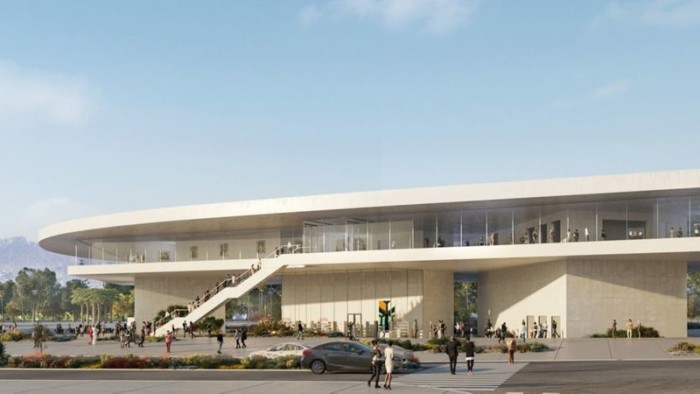
With Brad Pitt and Diane Keaton as its cheering section, the Los Angeles County Museum of Art won unanimous approval Tuesday from the county Board of Supervisors for a $650-million new home that will span Wilshire Boulevard.
The five supervisors voted to certify the new building’s final environmental impact report, to approve demolition of four existing LACMA buildings and to release $117.5 million in county funds toward construction of Peter Zumthor’s design.
“This is a milestone moment, this is the big green light to go forward,” museum Director Michael Govan said in an interview after the vote.
Recently released revisions to the Zumthor design showing a 10% reduction in building sizeprovoked sharp criticism over per-square-foot costs that are 35% or more higher than recent museum projects in L.A. and San Francisco. Critics also have complained about the new museum’s aesthetics as well as the plan to replace permanent galleries of key collections with rotating exhibitions. Artist Oscar Pena spoke out at the Tuesday vote, calling the LACMA proposal “a half-baked design” and urging supervisors not to “rush into mediocrity.”
“My main problem is that LACMA — ostensibly the public museum of the city — has not involved the public in the process,” Pena said later in an interview, noting that only a few renderings of the latest iteration of Zumthor’s design have been disseminated and that a model of the future museum wasn’t going on public view until after the supervisors’ vote. “So the public has no way to assess the movements leading to this decision, because it’s been so tightly controlled.”
But Supervisor Sheila Kuehl, whose district includes most of LACMA, downplayed the criticisms.
“There have been a number of critiques, there always will be,” she said, comparing the LACMA complaints to early opposition against designs for Walt Disney Concert Hall, the Broad museum and the Museum of Contemporary Art.
Among the backers who appeared at the Kenneth Hahn Hall of Administration downtown were artist Thomas Houseago and Kerry Brougher, whose Academy Museum of Motion Pictures is rising next door to LACMA.
“One of the reasons we’re there is because of the project that’s before you today,” Brougher told supervisors.
In a bit of civic discourse reminiscent of speed dating, Pitt, Houseago and Keaton addressed the supervisors in quick succession, each talking fast and urgently to convey their support within the two-minute time allotment. Pitt called Zumthor “one of the great architects of our time.”
“He builds from the soul for the soul. … He’s an architect who builds moments,” said Pitt, who went further before Supervisor Janice Hahn cut him off by saying, “We only do one take here.”
Houseago credited Govan as a contributor to an L.A. cultural renaissance, a place where “critical mass is happening between different communities — actors, writers, filmmakers, artists, we’re coming together, we’re talking, and we’re realizing how powerful we are. And Michael in many ways is part of that.”
Supervisor Kathryn Barger praised Govan, who hopes to offset the loss of gallery space in the new building with future satellite exhibition space in South Los Angeles and elsewhere.
“You really do have a vision, and it’s not just about four walls,” Barger said, later adding: “We believe it’s important to give exposure to people who wouldn’t otherwise have it.”
A Peter Zumthor rendering for LACMA shows the new building as it spans Wilshire Boulevard. (Atelier Peter Zumthor & Partner)
After the vote, Govan responded to criticism about a lack of transparency, including the absence of a floor plan for the new museum. “There’s been years and years of planning,” he said. “The people who need to make the decision have had full access to everything through the entire long process.” LACMA will release the Zumthor floor plan “very soon,” he said.
The next step for the project: The city of Los Angeles has its own approval process for the Zumthor building. The city controls the airspace above Wilshire, so before LACMA can begin construction, the city must vacate ownership of that airspace.
In May 2017, the City Council asked the Bureau of Engineering to begin studying the project. The council will vote after the bureau delivers its report. With city approval, LACMA can then obtain building permits.
Abatement — the process of preparing for demolition, including asbestos assessment — is planned for late 2019. Demolition of the four buildings will likely take place in early 2020, the museum said.
LACMA has been packing up more than 120,000 objects from its collection. About half the permanent collection galleries had closed by last June. Sections housing 17th century painting and sculpture, Medieval and Impressionist works and the Art of the Pacific closed earlier this year. Chinese and Korean galleries and modern galleries are slated to close this summer.
All art in the four buildings to be demolished should be cleared out and either on view in traveling exhibitions or moved into offsite storage by early fall, the museum said.
Throughout construction, LACMA will show rotating exhibitions from its permanent collection in its 2008 BCAM and 2010 Resnick buildings, which will remain part of the LACMA campus and have more than 100,000 square feet of combined gallery space.
LACMA’s fundraising for the Zumthor project has slowed, hovering around $560 million since December. (Among the pledges: $2.5 million from Ryan Seacrest in exchange for cafe naming rights, according to recent reporting in The Times.) LACMA said it will launch a more public phase of its fundraising, reaching out beyond board trustees and museum insiders to the broader public through mailings, phone calls and events.
The museum said it is aiming for “substantial completion” of the new building by the end of 2023. The public opening of the new building has been pushed to early 2024.
Source publication: LA Times